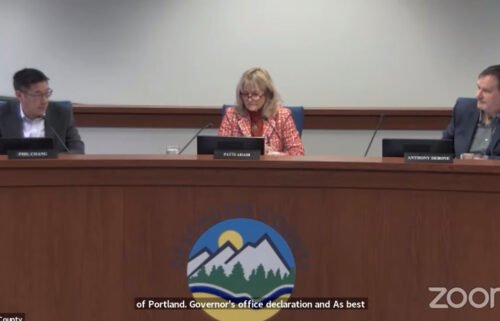For first time, US task force recommends screening adults for anxiety disorders

Adults ages 19 to 64 in the United States should be screened for anxiety disorders.
By Jacqueline Howard, CNN
(CNN) — Adults ages 19 to 64 in the United States should be screened for anxiety disorders, according to a new recommendation from the US Preventive Services Task Force released Tuesday.
The final recommendation, published in the medical journal JAMA, marks the first time the USPSTF has made a final recommendation on screening for anxiety disorders in adults, including those who are pregnant and postpartum. The task force found “insufficient evidence” to screen for anxiety in older adults.
The USPSTF, a group of independent medical experts whose recommendations help guide doctors’ decisions and influence insurance plans, also continues to recommend that all adults be screened for major depressive disorder, including those who are pregnant or postpartum and older adults.
The recommendation is consistent with the task force’s 2016 recommendation on depression screenings.
While rates of clinical depression had been rising steadily in the United States, they jumped significantly during the Covid-19 pandemic. In general, about 1 in 6 adults will have depression at some time in their life, according to the US Centers for Disease Control and Prevention.
And although depression and anxiety are different conditions, they commonly can happen together – and such screening recommendations can help clinicians identify which patients may need treatment for both conditions or one versus the other.
“Anxiety disorders are common, and they can really impact people’s quality of life, and what the task force found is that screening for anxiety disorders in the general adult population can lead to identifying these conditions early and then, if those people who are identified get linked up with appropriate care, they will benefit,” said Dr. Michael Silverstein, vice chair of the USPSTF and director of the Hassenfeld Child Health Innovation Institute at Brown University.
“So it really is extremely good news for the delivery of preventive services for the American public,” he said. “We also found that in the older adult population, which is defined as age 65 and older, that the task force really needs more evidence to weigh the risks and benefits of screening for anxiety disorders. And for that older adult population, we’re calling for urgent new research.”
‘We have not been treating mental health at the same level as physical health’
USPSTF researchers noted in their anxiety screening recommendation statement that most people with anxiety disorders don’t receive treatment within the first year of symptoms, if ever – showing a need for more robust screening.
“Only 11% of US adults with an anxiety disorder started treatment within the first year of onset; the median time to treatment initiation was 23 years,” the researchers wrote. “A US study of 965 primary care patients found that only 41% of patients with an anxiety disorder were receiving treatment for their disorder.”
Once the new screening recommendations are practiced in the real world, the results may reveal that anxiety disorders are much more prevalent than previously thought, said Dr. Georges Benjamin, executive director of the American Public Health Association, who was not involved in the recommendation statements.
“Anxiety has been way under the radar for a long time, and so I think it’s good that they are recommending for the broad population to be screened. When we start screening for anxiety, we’re going to find a lot more of it than we thought we had,” he said, adding that the nation should also prepare to make mental health services and treatments more easily accessible amid the ongoing mental health crisis.
“I think it’s an opportunity for us to get our hands around this crisis before we have a mental health emergency,” Benjamin said. “So we definitely have to do more. We know as a nation, we have under-invested in mental health. We have not put as much money into mental health. We have not been treating mental health at the same level as physical health. And we know that people who need mental health services are really struggling to find providers to care for them.”
What screening looks like
Medical professionals can screen for anxiety disorders using questionnaires and scales, such as asking about feeling on edge, not being able to stop or control worrying, or having trouble relaxing, for example.
Some questions used to screen for depression include asking about feeling hopeless, having trouble concentrating, losing interest in daily activities or thoughts about hurting yourself. Major depressive disorder is defined as at least two weeks of mild to severe persistent feelings of sadness or lack of interest in everyday activities, according to the USPSTF.
Any positive screening result should be confirmed with a diagnostic assessment to determine the severity of symptoms and identify any other psychological concerns, and then patients should be given care. Potential harms of screening include the risk of a false positive, leading to unnecessary appointments or unnecessary treatment, according to the USPSTF, but for most adults, screening and follow-up care can reduce symptoms of anxiety disorders and depression.
Effective treatments for anxiety disorders can include talking with a therapist, known as psychotherapy, or medications such as antidepressants or beta blockers, as well as relaxation or stress management therapies. Treatments for depression also can include antidepressant medication or psychotherapy, alone or in combination.
If left untreated, major depressive disorder “can interfere with daily functioning and can be associated with an increased risk of cardiovascular events, exacerbation of comorbid conditions, or increased mortality,” according to the USPSTF recommendation. Only about half of people with major depression are identified.
A call for more research on suicide risks
Research suggests that anxiety disorders and depression may be associated with suicidal thoughts, suicide attempts and other types of suicidal behaviors.
But the new USPSTF recommendations state that there is not enough evidence to recommend for or against screening specifically for suicide risk in adults who are not showing signs or symptoms, which is consistent with the task force’s 2014 recommendation on the issue.
“So if someone goes to the doctor or their primary care provider and expresses the idea of self-harm or wanting to hurt themselves or wanting to die by suicide, by all means, that provider needs to do everything they possibly can to help the patient in front of them,” Silverstein said.
“As a task force, we are not reviewing the evidence for that population,” he said. “We’re reviewing the evidence for people who come to their primary care provider without any signs or symptoms and having either the primary care provider or someone in the primary care provider’s office ask them a series of screening questions to assess their risk for suicide.”
In the new recommendations, the USPSTF calls for more research on suicide risks among people who are not showing signs or symptoms.
“Someone experiencing death by suicide is a tragedy,” Silverstein said. “Because the suicide rate in this country has been increasing, there are so many people who have experienced a loved one having died by suicide. So this recommendation is really important, and that importance to me underlines that the American public deserves the highest quality evidence around screening for this really, really serious condition, which is suicide risk.”
Mental health experts and advocates emphasize the importance of suicide risk assessments among adults diagnosed with anxiety and major depressive disorder.
“Although not called out in the USPSTF Recommendation Statement, a positive screen result for anxiety should be immediately followed with clinical evaluation for suicidality,” Dr. Murray Stein and Dr. Linda Hill, both of the University of California, San Diego, wrote in an editorial that accompanied the new recommendations in JAMA.
“The uptake of these new anxiety screening recommendations should provide an impetus and an opportunity for primary care clinicians to become more comfortable with diagnosing and treating anxiety disorders, which may require additional training,” they wrote. “Anxiety disorders can be distressing and disabling, and appropriate recognition and treatment can be life-altering and, in some cases, lifesaving, for patients.”
The-CNN-Wire
™ & © 2023 Cable News Network, Inc., a Warner Bros. Discovery Company. All rights reserved.



